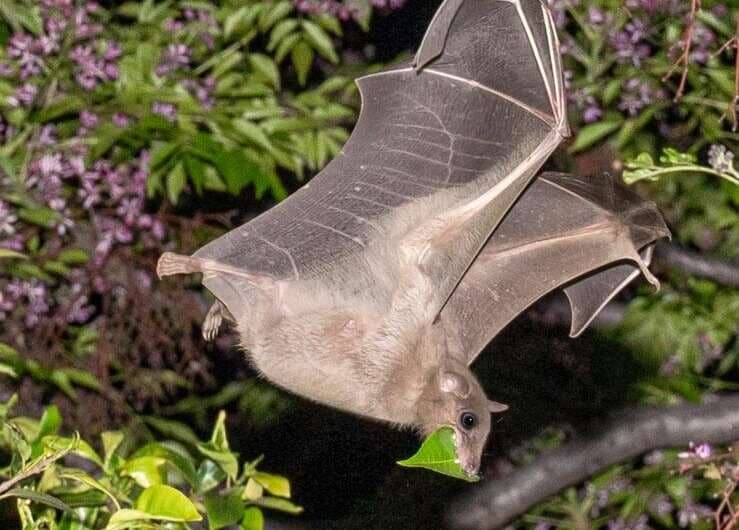This post was originally published on Eco Watch
Researchers from Tel Aviv University (TAU) have studied free-ranging fruit bats in a colony in Egypt to answer the long-standing question of whether animals have complex cognitive abilities previously thought to exist only in humans.
The study focused specifically on mental time travel, episodic memory, delayed gratification and planning ahead, a press release from TAU said.
“For many years, the cognitive abilities to recall personal experiences (episodic memory) and plan ahead were considered exclusive to humans. But more and more studies have suggested that various animals also possess such capabilities, but nearly all of these studies were conducted under laboratory conditions, since field studies on these issues are difficult to perform. Attempting to test these abilities in wild animals, we designed a unique experiment relying on the colony of free-ranging fruit bats based in TAU’s I. Meier Segals Garden for Zoological Research,” said Dr. Yossi Yovel, a lead researcher of the study and a professor in TAU’s School of Zoology and Sagol School of Neuroscience, in the press release.
The study, “Time-mapping and future-oriented behavior in free-ranging wild fruit bats,” was published in the journal Current Biology.
“Episodic memory is the memory of our individual experiences. In animals, people talk about episodic-like memory which is the ability to remember what-where and when an event happened. We show that bats remember how much time (when) passed since they visited a specific tree (what) at a specific location (where),” Yovel told EcoWatch in an email.
The research team surmised that bats who depend on fruit trees to survive would need to develop the ability to track food availability both spatially — where trees are located — and across time — when each tree produces fruit.
A fruit bat. Tel Aviv University
“We think that fruit bats map time in order to keep track of available fruit. For example, they know that if two weeks have passed since their last visit to one kind of tree, then there will be no food on that tree, but if only one week passed there might still be food. We show that they plan their visits according to such reasoning,” Yovel told EcoWatch.
To navigate landscapes with numerous nectar and fruit trees, the bats would also need to be able to mentally track resources so that they could revisit them at the right time.
The research team tested their hypothesis by attaching a small high-resolution GPS tracking device to each bat. This enabled them to document the bats’ flight routes as well as the trees they visited for many months. The team then analyzed the data they had compiled.
The first question the researchers asked was, “Do bats form a time map in their minds?”
In order to explore this issue, they prevented the bats from venturing outside their colony for varying time periods — from one day to an entire week.
“We wanted to see whether the bats could tell that time had elapsed and behave accordingly. We found that after one day of captivity, the bats would return to trees visited on the previous night. However, when a whole week had gone by, the older bats, based on past experience, avoided trees that had stopped bearing fruit in the interval,” said lead author of the study Dr. Lee Harten from the School of Zoology and Sagol School of Neuroscience in the press release. “In other words, they were able to estimate how much time had passed since their last visit to each tree, and knew which trees bore fruit for a short time and were no longer worth visiting. Young, inexperienced bats were unable to do this, indicating that this is an acquired skill that must be learned.”
“We suggest that [the bats’] reliance on food that is distributed in both time and space is the basis for developing spatio-temporal memory,” Yovel told EcoWatch.
The second pair of questions the research team asked was, “Do the bats exhibit future-oriented behaviors? Are they capable of planning ahead?”
To explore these issues, the team observed the route each bat took to the first tree they visited in the evening, which could indicate plans made before they left the colony.
“We found that usually the bats fly directly to a specific tree they know, sometimes 20 or 30 minutes away. Being hungry, they fly faster when that tree is further away, suggesting that they plan where they are heading. Moreover, focused on their chosen target, they will pass by other trees, even good sources visited just yesterday — indicating a capacity for delayed gratification. We also found that the first bats to leave the colony choose trees bearing fruits rich in sugar, while the bats that leave later seek proteins,” said co-author of the study Chen Xing, also with the School of Zoology, in the press release.
The findings of the study suggested that the bats planned their foraging before they left the colony and knew exactly where they were flying and the type of nourishment they were looking for.
“The cognitive gap between humans and animals is one of the most fascinating issues in science. Our study demonstrates that fruit bats are capable of quite a complex decision-making process involving the three questions indicative of cognitive abilities: Where? (each tree’s location); When? (when the tree bears fruit); and What? (the nourishment it provides — sugar vs. proteins),” Yovel said in the press release. “Once again, we find that the gap is not clean-cut, and that humans are not as unique as some might think. Apparently, humans and animals are all located on a spectrum, with almost any human ability found in animals as well.”
Yovel and the research team have plans for the further study of bats’ cognitive capabilities.
“We would really like to study their spatio-temporal memory over years. We also hope to examine how such memories are encoded in their brain,” Yovel told EcoWatch.
Based on the findings of the recent study, should humans reevaluate how they look at the cognitive abilities of bats and other animals?
“Depends on which humans,” Yovel said with a smile. “In my lab we never underestimated bats, but yes – many people think that bats and animals in general are simple instinct-based machines. That is clearly wrong. Animal cognition should be thought of as a continuum. In many cases humans are on one edge of this continuum but they are never alone.”
The post Fruit Bats Have Cognitive Abilities Previously Believed to Be Exclusive to Humans, Research Finds appeared first on EcoWatch.





0 Comments